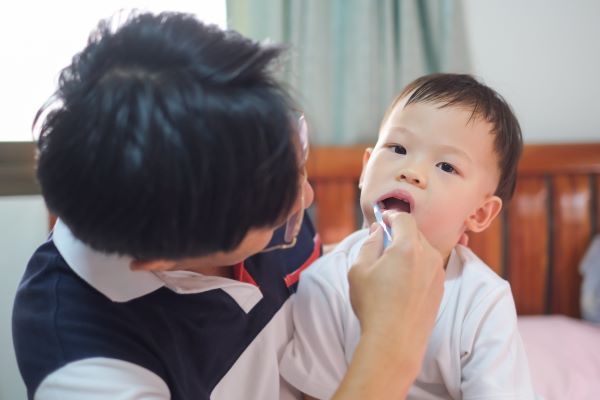
Having a regular bedtime routine helps children know what to expect at the end of the day. Brushing children’s teeth is an important part of the routine.
This Brush Up on Oral Health tip sheet describes the Brush, Book, Bed program developed by the American Academy of Pediatrics. The purpose of the program is to structure children’s bedtime routines. It includes recommendations that Head Start staff can share with parents for choosing children’s books on oral health.
Helping Parents Set a Bedtime Routine
Some parents share with Head Start staff that getting their child to bed is stressful. They say their child makes excuses to delay going to bed. Some children throw tantrums, ask for a snack, or leave the bedroom.
To help parents set a bedtime routine that takes the battle out of getting children to bed, use the Brush, Book, Bed program. It promotes three simple and clear messages that Head Start staff can share with parents:
- Brush. Brush the child’s teeth or supervise the child’s brushing. For children under age 3, use a smear of fluoride toothpaste to brush teeth. For children ages 3 to 6, use a pea-size amount of fluoride toothpaste. For more information about fluoride toothpaste amounts, see Healthy Habits for Happy Smiles: Brushing Your Child’s Teeth. After brushing, do not give the child anything to eat or drink before bed.
- Book. After brushing, let the child pick one or two books. Read the books aloud to the child in a comfortable spot.
- Bed. After reading, put the child to sleep in his or her bed. Sleep is important for children’s health and well-being.
It is important to stress to parents that consistency is the key to this approach. It may take some time to establish the routine. Once the routine is set, bedtime will become more pleasant for the parents and the child.
Helping Parents Choose Books

Head Start staff can help parents understand that spending 15 minutes reading aloud every day can improve a child’s language development. It also promotes positive social and emotional development by creating a strong parent-child bond. Reading books about oral health is a good way to do both of these things and teach children about oral health at the same time.
A wide variety of children’s books about oral health can be found in public libraries, bookstores, and discount stores. Books can be used to teach children about teeth and what they do, healthy foods and drinks, brushing teeth, visiting a dental office, and dentists’ and dental hygienists’ jobs.
Head Start staff can help parents choose books about oral health for their child by suggesting titles or encouraging parents to read books that meet the following recommendations:
- Information in the book is correct. If you are not sure the oral health information in the book is accurate, ask your state dental hygienist liaison (DHL). For information about state DHLs, see Brush Up on Oral Health: Understanding the Role of Dental Hygienist Liaisons.
- The book says positive things about oral health. Find a book that has positive messages and images about oral health. For example, a book about a dentist, dental hygienist, or dental office receptionist who is friendly can help a child feel good about dental visits. A book about a dentist or dental hygienist that praises a child for not having tooth decay is better than one about having a cavity filled.
- The book does not use words that might make a child afraid of dental visits. Look for words like shot, hurt, needle, pain, and other words that might scare a child. Do not read books with these words to a child because it might make the child afraid of dental visits.
- The book uses words that a child can understand. Make sure the book has short sentences and simple words. Check that the meanings of oral health terms are explained so a child can understand them.
Head Start programs can also keep books on oral health in the classroom. Parents can read the books to their children on site. If the Head Start program has a lending library, parents can check the books out.
Download a PDF version to print and share.
Read more:
Resource Type: Article
National Centers: Health, Behavioral Health, and Safety
Audience: Teachers and Caregivers
Series: Brush Up on Oral Health (BUOH)
Last Updated: April 25, 2023
